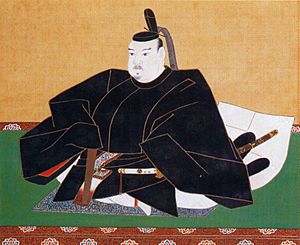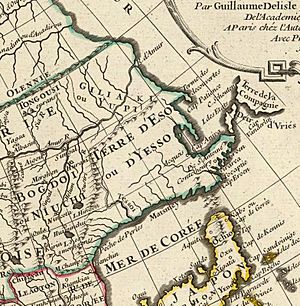Maarten Gerritsz Vries facts for kids
Maarten Gerritszoon Vries (born February 18, 1589, in Harlingen, Netherlands – died late 1647, near Manila) was a Dutch mapmaker and explorer in the 1600s. He was the first Western European to write about his visits to Ezo (now Hokkaidō), Sakhalin, the Kuril Islands, and the Sea of Okhotsk.
Not much is known about Maarten Gerritszoon Vries's early life. He likely spent many years in Taiwan. He is best known for his 1643 journey to the north-western Pacific Ocean. This trip aimed to find the coast of a place called Tartaria. It was ordered by Anthony van Diemen, the governor in Batavia (today's Jakarta, Indonesia). This was the second expedition looking for legendary gold and silver islands in the Pacific. The first attempt in 1639, led by Matthijs Quast, had not found them.
Contents
De Vries's Big Expedition
In February 1643, two ships, the Castricum led by De Vries and the Breskens led by Hendrick Cornelisz Schaep, left Batavia. After stopping in Ternate in the Moluccas, they continued their journey on April 4. On May 20, a storm caused the two ships to lose sight of each other. This happened near Hachijō-jima, an island about 290 kilometers south of Edo (now Tokyo). The Dutch named this island Ongeluckich, meaning "Unlucky," because of the storm.
The Breskens Visits Yamada

The Breskens found a promising bay and was welcomed by the people of Yamada on the Tohoku coast of Japan. Six weeks later, the Breskens returned to Yamada. On July 29, ten crew members, including the captain, were invited to a farm. They were offered sake (Japanese rice wine) and rice. However, they were then captured and sent to Morioka and Edo for questioning.
Japanese officials were worried that the visitors might be Jesuits (Catholic missionaries) from Portugal or Spain. Japan at that time was very strict about foreign visitors and religion. After it was clear that the crew were Dutch traders and not Catholics, the Japanese decided to release them. The crew had to wait nine months for a ship to Taiwan. Meanwhile, the Breskens had already left Honshu at the end of July, without its captain, to continue searching for the Gold and Silver Islands.
The Castricum Sails North

In the summer of 1643, the Castricum sailed past the southern Kuril Islands. They visited Kunashir, Iturup (which they called "Staten Island"), and Urup. On Urup, they met the Ainu people and claimed the island for the Netherlands, naming it "Company Island."
The Castricum sailed between Iturup and Urup. This passage was later named Vries Strait after Maarten Gerritszoon Vries. The ship then entered the Sea of Okhotsk.
The Dutch ship continued sailing north but did not find any land. Eventually, strong winds pushed them south-west towards the northern shores of Hokkaidō. They then sailed north again, discovering Cape Aniva (the southeastern tip of Sakhalin Island), the Gulf of Patience (where they had to wait for fog to clear), and Cape Patience to its east.
After another trip, this time east into the Pacific, the Castricum returned to Japanese waters. It managed to meet up with the Breskens near Kyūshū. The two ships then sailed to Fort Zeelandia (Taiwan) and returned to Batavia in mid-December 1643.
Later Life and Death
Maarten Gerritsz Vries died from a disease while at sea near Manila. This happened after he led an attempt to invade the Philippines, which was not successful.
See also
 In Spanish: Maarten Gerritsz Vries para niños
In Spanish: Maarten Gerritsz Vries para niños


